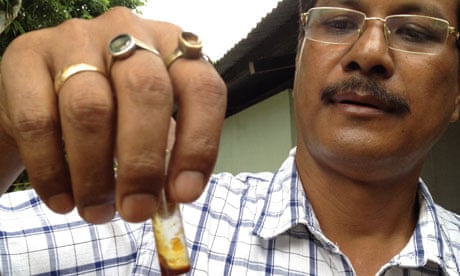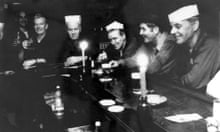"Look at this," said Dr Anuj Baruah, holding up a vial containing a few drops of rusty red liquid. "With this I could make you senseless." His nose started twitching; his eyes watered. "Oh dear. I think I may have got some on my fingers," he said, looking remarkably unconcerned that his skin had touched something the Indian government has developed into a biological weapon.
"I know what happens. Your brain starts to not work properly, you become restless … " He scurried off, returning a few minutes later after washing a particularly pungent strain of bhut jolokia chilli concentrate off his hands on his farm-cum-chilli research lab in the north-east Indian state of Assam.
When Assam's bhut jolokia was certified by the Guinness Book of Records as being the world's hottest chilli in 2007, it was a source of intense pride in the deprived state. Five years on, its title may have been challenged, but the subcontinent's celebrated super chilli is offering thousands of farmers a possible route out of poverty – and being supplied for potential use in controlling crowds and quelling riots.
When word got around about its Guinness entry, masochists the world over started offering ridiculous sums to get their hands on the spiciest chilli on the planet – once used by farmers to repel marauding elephants. One woman made it into the record books herself after eating 51 in one sitting under the horrified gaze of Gordon Ramsay.
The Assamese government wanted in. Farmers were offered subsidies to cultivate the plant, with some famous tea gardens in upper Assam even getting in on the act.
Trinity, an NGO, has selected another 2,000 Assamese farmers to grow the crop, said Nagen Talukdar, Trinity's secretary, last week. There is serious money to be made for anyone with the wherewithal to preserve their crops – a kilo of dried bhut jolokia sells for about 1,800 rupees (£21), a fortune for the average farmer, who generally survives on a subsistence level, taking home 150 rupees (£1.72) a day.
While there is a strong international market from so-called chilli-heads looking to blow their mouths off, the real demand is likely to come from India's ministry of defence, said Baruah, who sells bhut jolokia seeds and powder on the global market as well as acting as a consultant to farmers wanting to start growing the crop.
A biotechnologist, Baruah had been casually cultivating bhut jolokia for years at home; his mother used to preserve them in mustard oil and give her sons a few drops when they had an upset stomach. But he knew the chilli had potential outside the culinary and medicinal arenas.
He quit his job at a state-run petroleum research institute and started experimenting in a makeshift laboratory he set up on a patch of land rented from a local tribe in Khetri, 25 miles from Guwahati, Assam's main city. Soon, the defence ministry came calling: could he figure out a way of extracting the chemical pigment capsaicin from bhut jolokia? If so, could the Defence Research Laboratory in Tezpur, Assam, have 8kg for "research".
With a loan he bought an extraction machine and, with the help of two assistants, fulfilled the order in three months, refining the process to such a degree that he managed to produce 90% capsaicin. "I still don't know exactly what they were planning to do with it," he said, musing that you could, for example, "blast a container of capsaicin into a terrorist hideout and make them all drop their guns when they take just one breath." It was then he jovially warned he could make the Guardian "senseless" with a vial of oily red capcaisin he had extracted. "I could even decide for how long I wanted you to be unconscious by varying the dose," he said, smiling.
Last year it was reported that the Central Reserve Police Force – India's largest armed force, which specialises in counter-insurgency – had started using chilli grenades to blast at stone throwers in the perennially tense Kashmir region.
Then last month, police in Uttar Pradesh, India's most populous state, reportedly asked the home affairs ministry to be allowed to buy chilli grenades for crowd control.
While business is booming, the latest edition of the Guinness Book of Records brought a cruel blow to Assam, when bhut jolokia was usurped as the hottest chilli by an Australian upstart, the Trinidad Scorpion Butch T. Then in February this year, the Trinidad Moruga Scorpion took the Butch T's crown in tests run by experts at New Mexico State University's Chile Pepper Institute.
Baruah insists it isn't curtains for bhut jolokia. "The others aren't really available to buy easily," he said. "We can still boast of growing the world's hottest commercially available chilli." Plus, he said, bhut jolokia has centuries of spicy heritage, unlike these johnny-come-latelies. "Only after a chilli has kept its heat for a few generations can you stake a claim to its real pungency."




